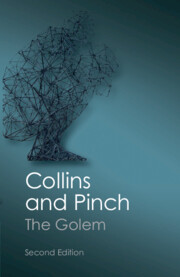Book contents
- Frontmatter
- Dedication
- Contents
- Preface to second edition
- Preface to first Canto edition
- Preface and acknowledgements
- Introduction: the golem
- 1 Edible knowledge: the chemical transfer of memory
- 2 Two experiments that ‘proved’ the theory of relativity
- 3 The sun in a test tube: the story of cold fusion 5
- 4 The germs of dissent: Louis Pasteur and the origins of life
- 5 A new window on the universe: the non-detection of gravitational radiation
- 6 The sex life of the whiptail lizard
- 7 Set the controls for the heart of the sun: the strange story of the missing solar neutrinos
- Conclusion: putting the golem to work
- Afterword: Golem and the scientists
- References and further reading
- Index
7 - Set the controls for the heart of the sun: the strange story of the missing solar neutrinos
Published online by Cambridge University Press: 05 February 2014
- Frontmatter
- Dedication
- Contents
- Preface to second edition
- Preface to first Canto edition
- Preface and acknowledgements
- Introduction: the golem
- 1 Edible knowledge: the chemical transfer of memory
- 2 Two experiments that ‘proved’ the theory of relativity
- 3 The sun in a test tube: the story of cold fusion 5
- 4 The germs of dissent: Louis Pasteur and the origins of life
- 5 A new window on the universe: the non-detection of gravitational radiation
- 6 The sex life of the whiptail lizard
- 7 Set the controls for the heart of the sun: the strange story of the missing solar neutrinos
- Conclusion: putting the golem to work
- Afterword: Golem and the scientists
- References and further reading
- Index
Summary
The many stars we see burning in the night sky have one thing in common. They all convert matter into energy by a process known as nuclear fusion. This is the same process that occurs in hydrogen bombs. Because stars are continually eating up their own mass of hydrogen over time, they slowly change. The process of change or evolution is usually gradual, but can have dramatic moments such as the cataclysmic end of a star in a huge explosion, a supernova. The changing history of stars, including our own sun, is described by stellar evolution theory: one of the most fundamental theories in modern astrophysics. This theory successfully explains the different transitions undergone by most stars. For astronomers and astrophysicists, stellar evolution theory is taken for granted as much as Darwin's theory of evolution is for biologists.
Yet, despite the undoubted successes of the theory, its central assumption – that nuclear fusion is the source of a star's energy – has only recently been directly tested.
In 1967, Ray Davis, of the Brookhaven National Laboratory, tried to detect solar neutrinos: sub-nuclear particles produced by nuclear fusion in our own sun. This was the first direct experimental test of stellar evolution theory. All other radiation coming from the sun is the result of processes that took place millions of years earlier. For example, light rays take millions of years to escape from the sun's core as they work their way to the surface. Neutrinos, because they interact so little with matter, travel straight out of the sun.
- Type
- Chapter
- Information
- The GolemWhat You Should Know About Science, pp. 121 - 138Publisher: Cambridge University PressPrint publication year: 2012



